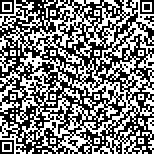| 引用本文: |
高勇, 李克亚, 王真权, 陈大光, 吕照文, 张晓芳.复方芩柏汤调控ERK/JNK信号通路治疗溃疡性结肠炎的效应及机制研究[J].湖南中医药大学学报,2024,44(5):764-770[点击复制] |
|
| |
|
|
| 本文已被:浏览 883次 下载 387次 |
| 复方芩柏汤调控ERK/JNK信号通路治疗溃疡性结肠炎的效应及机制研究 |
| 高勇,李克亚,王真权,陈大光,吕照文,张晓芳 |
| (宁乡市人民医院, 湖南 长沙 410600;湖南中医药大学第二附属医院, 湖南 长沙 410005) |
| 摘要: |
| 目的 研究复方芩柏汤对细胞外信号调节激酶(extracellular regulated protein kinases, ERK)/c-Jun氨基末端激酶(c-Jun N-terminal kinase, JNK)信号通路的调控作用,以及对溃疡性结肠炎(ulcerative colitis, UC)小鼠血清中炎症因子的影响。方法 将60只SPF级健康雄性BALB/C小鼠利用3%葡聚糖硫酸(dextran sulfate sodium, DSS)建立UC模型,造模成功后随机分为模型组(以生理盐水灌肠)、美沙拉嗪组(以0.196 g/kg美沙拉嗪药液灌肠)、复方芩柏汤组(以1.092 g/kg复方芩柏颗粒剂药液灌肠),每组20只,每天保留灌肠2次,连续3周。另取20只正常饲养小鼠作为空白组。在治疗前和治疗后第7、14、21天,观察小鼠体质量、大便性状、便血情况,并计算疾病活动指数(disease activity index, DAI),且于给药结束后进行麻醉取血并取结肠组织。采用HE染色观察各组小鼠结肠组织病理变化情况;ELISA法检测各组小鼠血清中炎症因子白细胞介素(interleukin)-22、IL-6、IL-10、肿瘤坏死因子-α(tumor necrosis factor-α, TNF-α)含量变化情况;采用Western blot法检测各组小鼠结肠组织中的p90核糖体蛋白S6激酶(p90 ribosomal protein S6 kinase, p90RSK)、JNK、磷酸化c-Jun氨基末端激酶(phosphorylated c-Jun N-terminal kinase, p-JNK)、细胞外调节蛋白激酶1/2(extracellular regulated protein kinases 1/2, ERK 1/2)、磷酸化细胞外调节蛋白激酶1/2(phospho extracellular regulated protein kinases, p-ERK 1/2)蛋白的表达。结果 在治疗的第7、14、21天,美沙拉嗪组、复方芩柏汤组小鼠体质量均明显高于模型组(P<0.05,P<0.01),DAI评分明显低于模型组(P<0.05,P<0.01)。光镜下,与模型组相比,美沙拉嗪组及复方芩柏汤组小鼠结肠组织病理改变呈不同程度的恢复,炎症浸润减轻。给药结束后,与空白组比较,模型组p90RSK、p-JNK、p-ERK 1/2蛋白以及IL-6、TNF-α蛋白表达明显升高(P<0.01);与模型组比较,美沙拉嗪组和复方芩柏汤组p90RSK、p-JNK、p-ERK 1/2蛋白以及IL-6、TNF-α蛋白表达明显降低(P<0.05,P<0.01),抗炎因子IL-22、IL-10含量明显升高(P<0.01)。结论 复方芩柏汤可能通过抑制ERK/JNK信号通路,促进抗炎因子IL-22、IL-10的表达,抑制促炎因子IL-6、TNF-α的表达,减少肠道炎症反应,促进肠上皮细胞增殖,改善肠黏膜屏障,促进UC小鼠肠道黏膜组织损伤修复。 |
| 关键词: 溃疡性结肠炎 复方芩柏汤 炎症因子 p90核糖体蛋白S6激酶 c-Jun氨基末端激酶 磷酸化c-Jun氨基末端激酶 细胞外调节蛋白激酶1/2 磷酸化细胞外调节蛋白激酶1/2 |
| DOI:10.3969/j.issn.1674-070X.2024.05.007 |
| 投稿时间:2023-06-25 |
| 基金项目:湖南省自然科学基金项目(S2012J5043);湖南省中医药管理局项目(2021020);湖南省中医药管理局一般项目(201786);长沙市自然科学基金项目(kq2202482);湖南中医药大学校级科研基金项目(2019XJJJ129)。 |
|
| Effects of compound Qinbai Decoction on regulation of ERK/JNK signaling pathway in treating ulcerative colitis and its mechanism |
| GAO Yong, LI Keya, WANG Zhenquan, CHEN Daguang, LYU Zhaowen, ZHANG Xiaofang |
| (People's Hospital of Ningxiang City, Changsha, Hunan 410600, China;The Second Hospital of Hunan University of Chinese Medicine, Changsha, Hunan 410005, China) |
| Abstract: |
| Objective To study the regulatory effects of compound Qinbai Decoction (QBD) on the extracellular regulated protein kinases (ERK)/c-Jun N-terminal kinase (JNK) signaling pathway, as well as its effects on inflammatory factors in the serum of mice with ulcerative colitis (UC). Methods Sixty SPF grade healthy male BALB/C mice were used to establish a UC model using 3% dextran sulfate sodium (DSS). After successful modeling, they were randomized into model group (enema with normal saline), mesalazine group (enema with 0.196 g/kg mesalazine solution), and compound QBD group (enema with 1.092 g/kg compound Qinbai Granule), with 20 mice in each group. The enema was administered twice a day for 3 consecutive weeks. An additional 20 normally fed mice were used as blank group. Before treatment and on the 7th, 14th, and 21st day after treatment, the body mass, stool characteristics, and bloody stool situation of the mice were observed, and the disease activity index (DAI) was calculated. The mice were anesthetized for blood and colon tissue collection after completion of administration. HE staining was used to observe the pathological changes of colon tissues in each group of mice; ELISA method was applied to check changes in the content of inflammatory factors such as interleukin-22, IL-6, IL-10, and tumor necrosis factor-α (TNF-α) in mice serum in each group; Western blot was employed to examine the expressions of p90 Ribosomal protein S6 kinase (p90 RSK), JNK, phosphorylated c-Jun N-terminal kinase (p-JNK), extracellular regulated protein kinases 1/2 (ERK 1/2), and phospho extracellular regulated protein kinases 1/2 (p-ERK 1/2) in the colon tissue of mice in each group. Results On the 7th, 14th, and 21st day of treatment, the body mass of mice in the mesalazine and compound QBD groups were significantly higher than those in the model group (P<0.05, P<0.01), and the DAI score was significantly lower than that in model group (P<0.05, P<0.01). Under the light microscope, compared with the model group, the pathological changes in the colon tissue of mice in the mesalazine and the compound QBD groups showed varying degrees of recovery, with reduced inflammation infiltration. After administration, compared with the blank group, the model group showed a significant increase in the protein expressions of p90RSK, p-JNK, p-ERK 1/2, as well as IL-6 and TNF-α (P<0.01). Compared with the model group, the mesalazine and the QBD groups showed a significant decrease in the protein expressions of p90RSK, p-JNK, p-ERK 1/2, as well as IL-6 and TNF-α (P<0.05, P<0.01), while the content of anti-inflammatory factors IL-22 and IL-10 significantly increased (P<0.01). Conclusion Compound QBD may promote the expressions of anti-inflammatory factors IL-22 and IL-10 and inhibit the expressions of proinflammatory factors IL-6 and TNF-α, reduce intestinal inflammatory response, promote intestinal epithelial cell proliferation, improve intestinal mucosal barrier, and promote the repair of intestinal mucosal tissue damage in UC mice by inhibiting the ERK/JNK signaling pathway. |
| Key words: ulcerative colitis compound Qinbai Decoction inflammatory factor p90 Ribosomal protein S6 Kinase c-Jun N-terminal kinase phosphorylated c-Jun N-terminal kinase extracellular regulated protein kinases 1/2 phospho extracellular regulated protein kinases 1/2 |
|

二维码(扫一下试试看!) |
|
|
|
|




